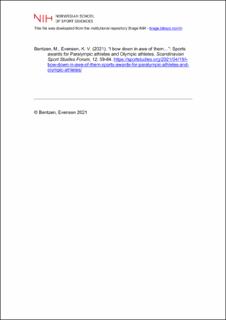| dc.contributor.author | Bentzen, Marte | |
| dc.contributor.author | Evensen, Kristin Vindhol | |
| dc.date.accessioned | 2021-06-07T07:05:10Z | |
| dc.date.available | 2021-06-07T07:05:10Z | |
| dc.date.created | 2021-05-11T12:58:42Z | |
| dc.date.issued | 2021 | |
| dc.identifier.citation | Scandinavian Sport Studies Forum. 2021, 12, 59-84. | en_US |
| dc.identifier.issn | 2000-088X | |
| dc.identifier.uri | https://hdl.handle.net/11250/2758052 | |
| dc.description.abstract | Paralympic athletes receive less media attention than Olympic athletes. Further, Olympic athletes are honoured for athletic achievements, whereas Paralympic athletes have been described as victims, suffering or heroic. Following researchers who have approached normativity and compulsory able-bodiedness in the light of hegemony and sub-hegemony, the current study explores whether sports media are sluggish when presenting athletes with disabilities, or if the picture is a more nuanced one. The context studied was the Norwegian Sports Awards (2001–2018). All introductions to the awards of the following categories were transcribed: Best male athlete, best female athlete, best Paralympian (2002–2012)/best male Paralympian and best female Paralympian (2013–2018). A six-step reflexive inductive thematic analysis was used to analyse the data (Braun & Clarke, 2019). The results indicated that the introduction of elite athletes with disabilities had some prominent hallmarks. Athletes with disabilities (‘they’) are different from those living without disabilities (‘us’). Athletes with disabilities are inspiring. Achievements of athletes with disabilities are placed in the shade, while disabilities are placed to the fore. An overall hegemony shows when best male and best female athlete are introduced: Female athletes are, to a large degree, described as developing and joked about in sexual manners, whereas male athletes are world-leading. This study provides the opportunity to learn from examples that balance the recognition of elite athletes with disabilities experiencing challenges in daily living with recognition of their athletic achievements. Thus, we suggest that this study adds nuance to the previous research within this context. | en_US |
| dc.language.iso | nob | en_US |
| dc.subject | ability | en_US |
| dc.subject | crip theory | en_US |
| dc.subject | media portrayal | en_US |
| dc.subject | paralympic athletes | en_US |
| dc.subject | parasports | en_US |
| dc.title | “I bow down in awe of them…”: Sports awards for Paralympic athletes and Olympic athletes | en_US |
| dc.type | Peer reviewed | en_US |
| dc.type | Journal article | en_US |
| dc.description.version | publishedVersion | en_US |
| dc.rights.holder | © Marte Bentzen, Kristin Vindhol Evensen 2021 | en_US |
| dc.source.pagenumber | 59-84 | en_US |
| dc.source.volume | 12 | en_US |
| dc.source.journal | Scandinavian Sport Studies Forum | en_US |
| dc.identifier.doi | https://sportstudies.org/2021/04/19/i-bow-down-in-awe-of-them-sports-awards-for-paralympic-athletes-and-olympic-athletes/ | |
| dc.identifier.cristin | 1909433 | |
| dc.description.localcode | Institutt for lærerutdanning og friluftslivsstudier / Department of Teacher Education and Outdoor Studies | en_US |
| cristin.ispublished | true | |
| cristin.fulltext | original | |
| cristin.qualitycode | 1 | |
